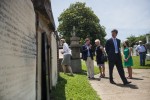 Timothy Shriver, son of Robert Sargent Shriver Jr. and Eunice Kennedy Shriver, brother of journalist and former California First Lady Maria Shriver, attended a memorial service Wednesday for relatives he didn’t know he had. They were prominent people in their day, but over time their final resting place in Washington, D.C.’s Congressional Cemetery had fallen into disrepair and was in dire need of restoration. Since the brick vault could not be repaired while the remains were still inside, in 2009 Douglas Owsley, head of the Natural History museum’s Physical Anthropology Department, was asked to excavate it and identify the remains for future reburial. After years of research and restoration, the skeletal remains of 16 people were reinterred in the tomb attended by a small group of Shriver relatives.
Timothy Shriver, son of Robert Sargent Shriver Jr. and Eunice Kennedy Shriver, brother of journalist and former California First Lady Maria Shriver, attended a memorial service Wednesday for relatives he didn’t know he had. They were prominent people in their day, but over time their final resting place in Washington, D.C.’s Congressional Cemetery had fallen into disrepair and was in dire need of restoration. Since the brick vault could not be repaired while the remains were still inside, in 2009 Douglas Owsley, head of the Natural History museum’s Physical Anthropology Department, was asked to excavate it and identify the remains for future reburial. After years of research and restoration, the skeletal remains of 16 people were reinterred in the tomb attended by a small group of Shriver relatives.
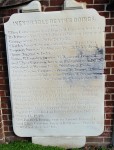 The Causten Vault was built in 1835 by lawyer and international diplomat James H. Causten after the tragic death of his first son, Charles Isaac, who passed away just days short of his second birthday. According to his obituary, little Charles “was a child of uncommon intelligence and excited the admiration and affectionate regard of all that knew him. His family have much cause to regret the early fall of one so interesting and promising.”
The Causten Vault was built in 1835 by lawyer and international diplomat James H. Causten after the tragic death of his first son, Charles Isaac, who passed away just days short of his second birthday. According to his obituary, little Charles “was a child of uncommon intelligence and excited the admiration and affectionate regard of all that knew him. His family have much cause to regret the early fall of one so interesting and promising.”
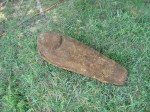 James Causten would outlive all but one of his children, and his daughter Josephine only outlived him by four years. His eldest daughter Henrietta Jane was the Shriver connection. She married Joseph Shriver, scion of an important Baltimore family that included a signer of the 1776 Maryland Constitution. Henrietta died in 1863 of a sudden heart attack when she was 52, “leaving both families overwhelmed in grief at this loss of their richest jewels.” She was buried in the vault, joining her daughter Josephine Shriver who had died 14 years before her mother at the age of four.
James Causten would outlive all but one of his children, and his daughter Josephine only outlived him by four years. His eldest daughter Henrietta Jane was the Shriver connection. She married Joseph Shriver, scion of an important Baltimore family that included a signer of the 1776 Maryland Constitution. Henrietta died in 1863 of a sudden heart attack when she was 52, “leaving both families overwhelmed in grief at this loss of their richest jewels.” She was buried in the vault, joining her daughter Josephine Shriver who had died 14 years before her mother at the age of four.
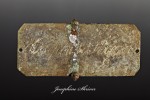 After his death in 1874 at the age of 86, Causten was buried in the family vault, which was already so sadly well-populated by then. It would eventually hold the remains of 22 members of the extended family, and that’s not counting the eight temporary residents who were placed in the vault while arrangements were made for permanent burials elsewhere. One of them was First Lady Dolley Madison. Her niece and adopted daughter was Annie Payne Causten, wife of Dr. James H. Causten Jr., the founder’s son. After Dolley died in July of 1849, she was buried in the Public Vault of the Congressional Cemetery ostensibly just until arrangements could be made to bury her by her husband’s side at his Virginia estate Montpelier. Unfortunately her gambling, alcoholic wastrel son, whose endless debts were a major reason for her poverty in old age, set aside no money for her burial. When he died of typhoid fever less than three years after his mother, she was still in the Public Vault. A month later, Annie Payne Causten had Dolley’s remains moved to the Causten Vault. Unfortunately she died a few months later aged just 33, so Dolley’s remains stayed in the vault for another six years. Finally the Caustens saw to it that she was buried in Montpelier.
After his death in 1874 at the age of 86, Causten was buried in the family vault, which was already so sadly well-populated by then. It would eventually hold the remains of 22 members of the extended family, and that’s not counting the eight temporary residents who were placed in the vault while arrangements were made for permanent burials elsewhere. One of them was First Lady Dolley Madison. Her niece and adopted daughter was Annie Payne Causten, wife of Dr. James H. Causten Jr., the founder’s son. After Dolley died in July of 1849, she was buried in the Public Vault of the Congressional Cemetery ostensibly just until arrangements could be made to bury her by her husband’s side at his Virginia estate Montpelier. Unfortunately her gambling, alcoholic wastrel son, whose endless debts were a major reason for her poverty in old age, set aside no money for her burial. When he died of typhoid fever less than three years after his mother, she was still in the Public Vault. A month later, Annie Payne Causten had Dolley’s remains moved to the Causten Vault. Unfortunately she died a few months later aged just 33, so Dolley’s remains stayed in the vault for another six years. Finally the Caustens saw to it that she was buried in Montpelier.
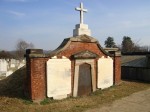 The last burials in the Causten Vault were at the end of the 19th century. After that, the fate of the vault matched the fate of the Congressional Cemetery. It stopped being a fashionable place for Washington politicos and society figures to be buried and gradually fell into neglectful decay. Vaults crumbled, headstones broke, drug dealers and prostitutes plied their trades amidst the historical dead. In 1976 the non-profit Association for the Preservation of the Historic Congressional Cemetery took over management of the cemetery, but it wasn’t until the '90s when volunteers and innovative programs began to boost restoration projects. Its inclusion on the National Trust for Historic Preservation’s list of America’s 11 Most Endangered Historic Places in 1997 brought it fresh attention, including, finally, some maintenance funding from Congress.
The last burials in the Causten Vault were at the end of the 19th century. After that, the fate of the vault matched the fate of the Congressional Cemetery. It stopped being a fashionable place for Washington politicos and society figures to be buried and gradually fell into neglectful decay. Vaults crumbled, headstones broke, drug dealers and prostitutes plied their trades amidst the historical dead. In 1976 the non-profit Association for the Preservation of the Historic Congressional Cemetery took over management of the cemetery, but it wasn’t until the '90s when volunteers and innovative programs began to boost restoration projects. Its inclusion on the National Trust for Historic Preservation’s list of America’s 11 Most Endangered Historic Places in 1997 brought it fresh attention, including, finally, some maintenance funding from Congress.
 Restoration is an ongoing process. The Causten Vault became a priority in 2009 because its mortar was crumbling and the barrel roof was on the verge of collapse. When Douglas Owsley and his team opened the tomb, they found that the interior was in even more dire condition. Over the years the shelves that held coffins had fallen apart, pancaking caskets and human remains in a chaotic pile several feet thick. The remains were carefully removed and transported to Owsley’s lab at the National Museum of Natural History.
Restoration is an ongoing process. The Causten Vault became a priority in 2009 because its mortar was crumbling and the barrel roof was on the verge of collapse. When Douglas Owsley and his team opened the tomb, they found that the interior was in even more dire condition. Over the years the shelves that held coffins had fallen apart, pancaking caskets and human remains in a chaotic pile several feet thick. The remains were carefully removed and transported to Owsley’s lab at the National Museum of Natural History.
Over the past five years, a team of archaeologists and anthropologists analyzed the skeletons taken from the vault, the hardware on the coffins (which helps date the caskets) and personal artifacts found inside. Bones provide all sorts of information, Owsley said, from gender and age to lifestyle (years of heavy labor, for example, take a toll), diet and probable cause of death.
In the final tally, the remains of 16 people were found. The six people known to have been buried in the vault whose remains were not found are thought to have been buried near the bottom of the vault where the damp conditions caused brushite to form on the bones and eventually disintegrate them. The remains of the 16 were identified and placed either in white boxes or in their original cast iron coffins, several of which survived in usable condition. They have all now been reinterred, with their family in attendance, in the Causten Vault.